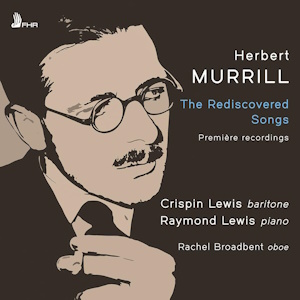
Herbert Murrill (1909-1952)
The Rediscovered Songs
Crispin Lewis (baritone)
Raymond Lewis (piano)
Rachel Broadbent (oboe)
rec. 2024, Rosslyn Hill Chapel, Hampstead, London
Texts included
First Hand Records FHR161 [55]
Herbert Murrill is known primarily for his choral and organ music but he wrote a jazz opera called Man in Cage, a large number of orchestral pieces, concertos (review) and piano music as well as songs. At the age of 24 he was the youngest ever professor of composition at the Royal Academy of Music and within a decade he was the BBC’s Music Programming Organiser where he seems to have been decidedly un-starchy and easy-going. During the war he was recruited to Bletchley Park working in codebreaking and intelligence, thereafter rejoining the BBC as its Head of Music. His death from cancer at the age of only 43 in 1952 was a great loss.
The songs are heard here in what FHR claims are all premiere recordings though I have to point out that the Three Carols for voice and oboe of 1930 have also been recorded by James Gilchrist and Mark Baigent on Oboe Classics CC2038 on their album called ‘What plaintive melodies are these?’ All the pieces on that disc are for tenor and oboe.
These song cycles date from 1927 to 1938. There’s one outlier, the charmingly decorated and baroque-tinged Arioso from the Piano Sonatina of 1953 and only one song from the busy 1940s, In Youth is Pleasure (1942), with which the disc begins, and which is cast in a broadly traditional British vocal style to which an imaginative piano part acts as a bracing companion. When one thinks of possible influences on Murrill one can turn to a host of contemporaries writing in the period to whom he could have listened – Walton, Berkeley, Britten, Vaughan Williams, Warlock, Finzi, Howells, Ireland, Moeran and Bridge are just some of the more obvious. But Murrill’s happiest milieu seems to have been in that hinterland inhabited by folklore, Butterworth, Warlock and Vaughan Williams. His muse was largely untroubled by the harmonic and other ambiguities of Ireland, the political acerbities of Britten and though he shared some Gallic interests with Berkeley he tended to be more circumspect musically and to separate his more Poulenc-like wit from the more obviously wryly witty traditional nature of his songs.
The 4 Songs (to Elizabethan Words) are pithy, bright and brisk. Genial folklore co-exists with a robust Warlock hommage and humour is seldom too far away – listen to the way the piano picks up the singer’s lines in The Bachelor. The Pastorals of 1936 again take his favoured Elizabethans to set, including George Wither, Samuel Daniel and old favourite Anon. These songs consider the general awfulness and inconstancy of love and maidens though they seem less engaged than the earlier set of 4 Songs of 1927-30. The 3 Poèmes are slightly unusual in taking two texts by Jacques Prévert and one by Robert Desnos and these ultra-short c.45-second songs are pithy, sparkling and full of boulevardier feel.
The two 1938 Songs take a favourite composer of the Elizabethan period, Robert Herrick, and make a distinct contrast, the first a rather low-key but thoughtful narrative, the second offering rather more activity in the piano writing. Murrill wrote Self-Portrait, to a text by the contemporary writer Geoffrey Dunn, a slightly older contemporary of Murrill, in 1929. In rather over-ornate 1920s cleverness the poet reflects upon his Self, Birth, Death and ‘Extranea’ subtitled Motum perpetuum. This at least gives Murrill something into which to dig and he responds suitably with wry reflection. In the second poem there are hints of Finzi, whilst the piano writing is cleverly wrought in the third where the vocal line is decidedly demotic. Of Death; Suburban Funerals is an off-hand setting with a dappled right hand full of colour. Maybe I shouldn’t find it as amusing as I do.
The oboe songs are 3 Carols (1929), and they’re much slower than the competitor recording noted above, sometimes dramatically so. Nevertheless, they’re evocative. The central one sports Scots dialect and the final setting, The Falcon, is particularly expressive. These are some of the most fulfilling of Murrill’s songs and the use of the oboe drew something tangibly different from him. It’s useful to remember that Vaughan Williams’ Blake Songs, also for voice and oboe, were composed almost three decades later.
The recording balance is well-judged in Rosslyn Hill Chapel, Hampstead, and there are full texts and a fine note from Crispin Lewis, who has also usefully transcribed the songs from various editions for performance (I’m not clear, though, whether any of the sets is actually written for baritone). He has a serviceable voice but it has a bleat that proves a bit obstructive and it’s not especially varied in colour. Nevertheless, the recording has achieved its aim of bringing these hitherto (largely) overlooked songs to the recorded public domain. Raymond Lewis is a good accompanist and oboist Rachel Broadbent plays eloquently in her songs.
Jonathan Woolf
Buying this recording via a link below generates revenue for MWI, which helps the site remain free

Contents
In Youth is Pleasure (1942)
The Months of the Year (1936?)
4 Songs (1927-30)
4 Pastorals (1936)
3 Poèmes (1930)
3 Carols for voice and oboe (1929)
Sonatina for Piano: II. Arioso (1953)
2 Songs (1938)
Self-Portrait (1929)


















